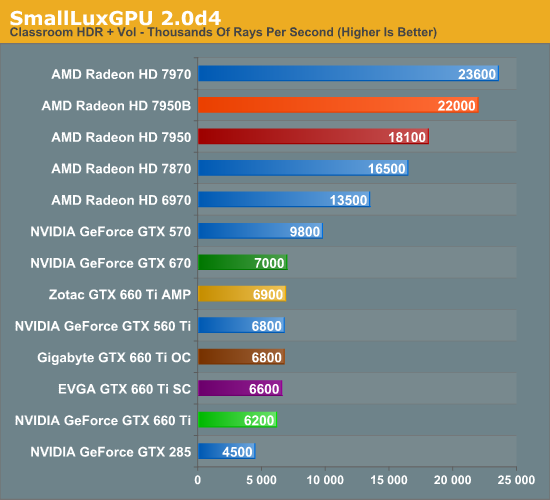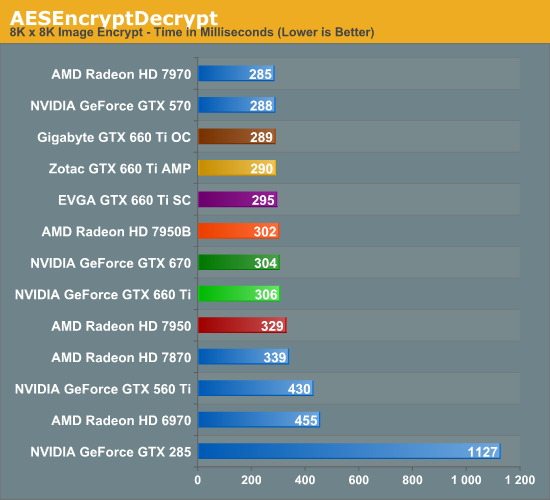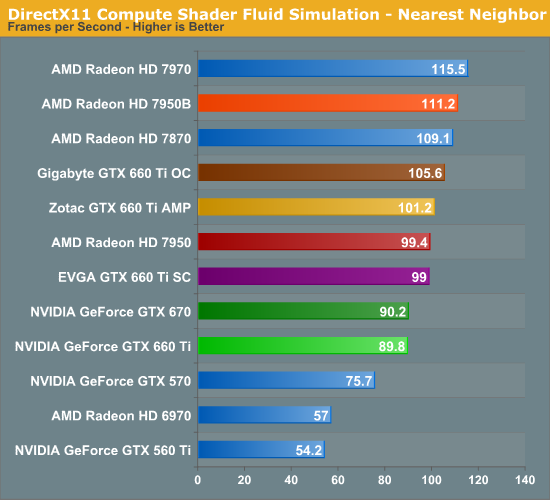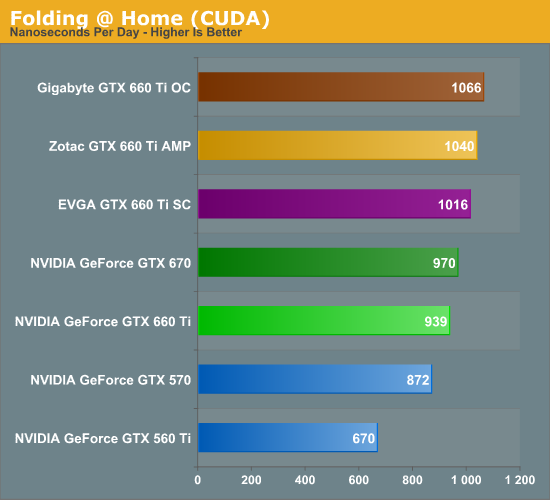The GeForce GTX 660 Ti Review, Feat. EVGA, Zotac, and Gigabyte
by Ryan Smith on August 16, 2012 9:00 AM ESTCompute Performance
Shifting gears, as always our final set of real-world benchmarks is a look at compute performance. As we have seen with GTX 680 and GTX 670, GK104 appears to be significantly less balanced between rendering and compute performance than GF110 or GF114 were, and as a result compute performance suffers. Cache and register file pressure in particular seem to give GK104 grief, which means that GK104 can still do well in certain scenarios, but falls well short in others. For GTX 660 Ti in particular, this is going to be a battle between the importance of shader performance – something it has just as much of as the GTX 670 – and cache/memory pressure from losing that ROP cluster and cache.
Our first compute benchmark comes from Civilization V, which uses DirectCompute to decompress textures on the fly. Civ V includes a sub-benchmark that exclusively tests the speed of their texture decompression algorithm by repeatedly decompressing the textures required for one of the game’s leader scenes. Note that this is a DX11 DirectCompute benchmark.

For Civilization V memory bandwidth and cache are clearly more important than raw compute performance in this test. Although this isn’t a worst case scenario outcome for the GTX 660 Ti, it drops substantially from the GTX 670. As a result its compute performance is barely better than the GTX 560 Ti, which wasn’t a strong performer at compute in the first place.
Our next benchmark is SmallLuxGPU, the GPU ray tracing branch of the open source LuxRender renderer. We’re now using a development build from the version 2.0 branch, and we’ve moved on to a more complex scene that hopefully will provide a greater challenge to our GPUs.

Ray tracing likes memory bandwidth and cache, which means another tough run for the GTX 660 Ti. In fact it’s now slower than the GTX 560 Ti. Compared to the 7950 this isn’t even a contest. GK104 is generally bad at compute, and GTX 660 Ti is turning out to be especially bad.
For our next benchmark we’re looking at AESEncryptDecrypt, an OpenCL AES encryption routine that AES encrypts/decrypts an 8K x 8K pixel square image file. The results of this benchmark are the average time to encrypt the image over a number of iterations of the AES cypher.

The GTX 660 Ti does finally turn things around on our AES benchmark, thanks to the fact that it generally favors NVIDIA. At the same time the gap between the GTX 670 and GTX 660 Ti is virtually non-existent.
Our fourth benchmark is once again looking at compute shader performance, this time through the Fluid simulation sample in the DirectX SDK. This program simulates the motion and interactions of a 16k particle fluid using a compute shader, with a choice of several different algorithms. In this case we’re using an (O)n^2 nearest neighbor method that is optimized by using shared memory to cache data.

The compute shader fluid simulation provides the GTX 660 Ti another bit of reprieve, although like other GK104 cards it’s still relatively weak. Here it’s virtually tied with the GTX 670 so it’s clear that it isn’t being impacted by cache or memory bandwidth losses, but it needs about 10% more to catch the 7950.
Finally, we’re adding one last benchmark to our compute run. NVIDIA and the Folding@Home group have sent over a benchmarkable version of the client with preliminary optimizations for GK104. Folding@Home and similar initiatives are still one of the most popular consumer compute workloads, so it’s something NVIDIA wants their GPUs to do well at.

Interestingly Folding @ Home proves to be rather insensitive to the differences between the GTX 670 and GTX 660 Ti, which is not what we would have expected. The GTX 660 Ti isn’t doing all that much better than the GTX 570, once more reflecting that GK104 is generally struggling with compute performance, but it’s not a bad result.










313 Comments
View All Comments
CeriseCogburn - Saturday, August 25, 2012 - link
nVidia= "drivers fixed immediately"amd= " drivers not fixed for years, and broken fixing something else"
JM Popaleetus - Thursday, August 16, 2012 - link
Ryan,Can we expect some benchmarks and data in regards to the 660 and further overclocking?
Ryan Smith - Thursday, August 16, 2012 - link
Going up now.bill4 - Thursday, August 16, 2012 - link
When I just checked newegg and there are no 660 TI in stock?Or for that matter, that 680 was impossible to find for *months*? Why is that OK? I saw NO reviewers ever nick Nvidia for that one...
Ryan Smith - Thursday, August 16, 2012 - link
Hi bill;That's a reasonable question.
First and foremost, it's 7am in the morning. Newegg doesn't always post stock updates this early, so GTX 660 Ti cards may not show up until a bit later in the day. Though EVGA already has their cards up on their site.
As for our concerns about launch availability, it's the difference between what is being claimed and what is being delivered. NVIDIA told us right from the start that the supply of the GTX 680 would be tight, and that's exactly what happened. AMD told us that the 7970GE would be available in late June, and that did not happen.
Mind you, AMD isn't having supply issues either. The 7970GE wasn't late because AMD was having any kind of trouble supplying partners with suitable GPUs.
antef - Thursday, August 16, 2012 - link
I got badly bitten this generation by the classic "new products are just around the corner" conundrum. I wanted to upgrade exactly this time last year but didn't because I wanted the new and more efficient 28nm AMD cards that were supposedly just around the corner. Instead, they came late and were a huge letdown: too expensive and not the kind of performance boost I was expecting. Then NVIDIA countered but only focused on the high-end for all these months. However it did seem that NVIDIA had the better, more efficient product. So I was waiting for their card in the $200-300 range and finally after a whole year it's here.The price is a bit high, but I'm tired of waiting and will probably jump on this. I like the cool and silent operation of the Gigabyte but Ryan speaks highly of the ZOTAC as well, not sure which to get.
Should I jump on this as soon as I see retail availability?
just4U - Thursday, August 16, 2012 - link
I have to disagree.. they were not a letdown at all.. Price seemed to be the only major complaint people were having. But in a way AMD has been on the ball. Their a step ahead of Nvidia in getting next gen products out and a half step behind in performance. To me that seems pretty good.rarson - Friday, August 17, 2012 - link
Yeah, and price was only an issue because people were ignoring economic and manufacturing factors and making unreasonable expectations.CeriseCogburn - Sunday, August 19, 2012 - link
Yeah sure there rarson, it wasn't AMD in a fit of corporate piggery and immense greed scalping the crap out of us and abandoning the gaming community for as long as they could possibly keep selling their junk at a huge inflated price.....Oh wait.... it was.
Galidou - Monday, August 20, 2012 - link
And would you stop exaggerating with your conspirations and overpriced SHIT language all over the place. What hurts the most in the past if we speak about pricing stupidity is probably buying an i7-980x cpu for 1100$ and then one week later sandy bridge gets out and tramples the cpu at 220-300$ price points with an i5-2500k and i7-2600k... speak about inflated prices for pieces of hardware that must cost not even 30$ to manufacture.Nvidia as any other company isn't being nicer, it's still based on maximum profit. They probably sell video cards that costs 20$ to manufacture and beleive me the profit doesn't go into funding environmental projects to get rid of all the electric wastes we create every year.
They pay developpers like any other company to get games optimized for their hardware and what's happening now, reduces our choices depending on the games we play. They still ask reviewers to ensure their products have the best performance in their reviews. That's, to me, liying to the consumer(US) so they sell more stuff. Even if their product is good(which they are), that's still manipulating the opinion, thus they do not work for the people, they work for the profit.
So... please, stop speaking about Nvidia like if everything they do has been decided by god before and thus is perfect in every way... it doesn't work. You won't be a better human nor be more happy if you play more game thanks to the performance of your video card, you'll just end up being more addicted and that's it.